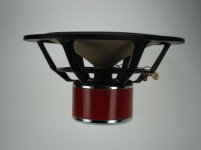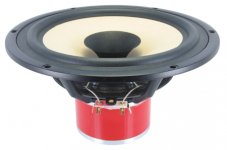It is in the latest website-first photo!:
http://www.seas.no/index.php?option=com_content&task=blogcategory&id=1&Itemid=172
As discussed here:
http://www.diyaudio.com/forums/showthread.php?s=&threadid=111236&perpage=25&pagenumber=1
Nelson pal-ing around with the SEAS folks is paying off for us!!
The efficientcy is about the minimum that most fulll range pepple will accept, BUT I think that it's enough..
http://www.seas.no/index.php?option=com_content&task=blogcategory&id=1&Itemid=172
As discussed here:
http://www.diyaudio.com/forums/showthread.php?s=&threadid=111236&perpage=25&pagenumber=1
Nelson pal-ing around with the SEAS folks is paying off for us!!
The efficientcy is about the minimum that most fulll range pepple will accept, BUT I think that it's enough..
paba said:so I'm getting this right? There are 2 fullrangers from SEAS...
The Exotic F8 as per the web site and the custom order unit for Nelson Pass called the X1 (in reference to the Pass Labs X1 perhaps) that may also be offered to the public in the future?
I am informed that it is an F8, just the pair I got are marked
X1. Possibly they were made before the model designation had
been decided.
>I have heard elsewhere that putting
>high values of resistance in series with
>the speaker "drains the life out".
It does a lot more than "drain the life out".
It actually mutes the highs to a large extent.
Looking at the impedance plot of a driver,
one would imagine that the highs as well as
the lows would be enhanced since the
'voltage divider' action lessens at both extremes.
I lack the technical savy to explain why the
highs are affected opposent to the lows, but
have confirmed it with many experiments and
drivers. It was once explained to me in terms
(IIRC) of the rising high end impedance being
beyond the 'mass corner' or somesuch ?
I don't know if there would be a differance between
a resistance and an active current source, but
do believe that your article on the subject is somewhat
misleading in that respect........
>high values of resistance in series with
>the speaker "drains the life out".
It does a lot more than "drain the life out".
It actually mutes the highs to a large extent.
Looking at the impedance plot of a driver,
one would imagine that the highs as well as
the lows would be enhanced since the
'voltage divider' action lessens at both extremes.
I lack the technical savy to explain why the
highs are affected opposent to the lows, but
have confirmed it with many experiments and
drivers. It was once explained to me in terms
(IIRC) of the rising high end impedance being
beyond the 'mass corner' or somesuch ?
I don't know if there would be a differance between
a resistance and an active current source, but
do believe that your article on the subject is somewhat
misleading in that respect........
hitsware said:I don't know if there would be a differance between
a resistance and an active current source, but
do believe that your article on the subject is somewhat
misleading in that respect........
In what manner?
hitsware said:>I have heard elsewhere that putting
>high values of resistance in series with
>the speaker "drains the life out".
Hitsware,
You'd be much better off if you could just build an F2. A simple and amazing amplifier. You'll simply enjoy the music and forget those 100w amps and series resistors...
p.s. I built an F2 lite and an ZV9 without feedback. Compared to them, 99% of class AB (100-200w) amps that I heard sounded lifeless...
Oh, this was off-topic.
On-topic... nice speaker! It bet it sounds good on an OB, run fullrange, with just a bit bass support...
>In what manner?
When you say (or at least imply) that the relative HF response as well as the LF response of a FR driver is accentuated by a series resistance.
My experience would indicate that the LF is (relatively) boosted but in fact the HF is attenuated (as well as muddled(but that's another issue?))
For instance (using the only driver we have in common (the Pioneer))....adding 25 Ohm series resistance.
You say you have to shelve down the highs.
When I add the resistance, I have to actually bypass it with a small (~0.33uf) cap to get the highs back .......
I don't think I am alone in this perception as I have never heard of anyone else saying that the highs as well as lows are enhanced by series resistance.
When you say (or at least imply) that the relative HF response as well as the LF response of a FR driver is accentuated by a series resistance.
My experience would indicate that the LF is (relatively) boosted but in fact the HF is attenuated (as well as muddled(but that's another issue?))
For instance (using the only driver we have in common (the Pioneer))....adding 25 Ohm series resistance.
You say you have to shelve down the highs.
When I add the resistance, I have to actually bypass it with a small (~0.33uf) cap to get the highs back .......
I don't think I am alone in this perception as I have never heard of anyone else saying that the highs as well as lows are enhanced by series resistance.
hitsware said:[BWhen you say (or at least imply) that the relative HF response as well as the LF response of a FR driver is accentuated by a series resistance.
My experience would indicate that the LF is (relatively) boosted but in fact the HF is attenuated (as well as muddled(but that's another issue?))
For instance (using the only driver we have in common (the Pioneer))....adding 25 Ohm series resistance.
You say you have to shelve down the highs.
When I add the resistance, I have to actually bypass it with a small (~0.33uf) cap to get the highs back .......
I don't think I am alone in this perception as I have never heard of anyone else saying that the highs as well as lows are enhanced by series resistance. [/B]
By actual measurement the high end response is increased for
the same reason that the low frequency is increased - more
current is going through the voice coil's higher impedance at
both the low frequency resonance and the inductance of the
top end.
A fine example of this is the curves on the Jordan 92, where a
current source gives about 6 dB more top end versus a voltage
source. The Pioneer BU20FU20 is also a good example of this,
where with the current source and parallel network we get about
an 8 dB boost at 20 Khz, and if you look at my network for it you
will see that I shelve the midrange, not the highs. In this regard,
you are creating a similar effect.
If you want to duplicate my results, you would place 23 ohms in
series with the output of your amplifier, and then you would use
a 33 uF in series with 10 ohms in series with .3 mH, this network
in parallel with the driver as shown in the article.
You might respond that this is not what you're hearing, and I
would not argue with your subjective results. The discrepancy
might go back to why "resistors suck the life out of the sound".
It has been observed that the sound is not the same with
resistors in series with a voltage source as resistors in parallel
with a current source. All things being equal, this should not be
the case, but I have not taken the time to further investigate it.
>more current is going through the
>voice coil's higher impedance at
>both the low frequency resonance
>and the inductance of the top end.
More current through higher impedance ?
>You might respond that this is not
>what you're hearing, and I would not
>argue with your subjective results.
Hmmm. Since you say +8db @ 20kHz
(nor would I argue with your instrumentation)
it's possible that my 'bypass cap' is
actually bringing the HP action
down to where I can hear it......?
I.E. undoing some of the upper part
of the midrange cut (which is how the
high and low 'boost' is achieved)......
>voice coil's higher impedance at
>both the low frequency resonance
>and the inductance of the top end.
More current through higher impedance ?
>You might respond that this is not
>what you're hearing, and I would not
>argue with your subjective results.
Hmmm. Since you say +8db @ 20kHz
(nor would I argue with your instrumentation)
it's possible that my 'bypass cap' is
actually bringing the HP action
down to where I can hear it......?
I.E. undoing some of the upper part
of the midrange cut (which is how the
high and low 'boost' is achieved)......
jnb said:If your bass impedance peaks higher than the top end, your bass may be playing louder. I occasionally find changes in bass level have me chasing treble levels to match it.
For sure. It's easy for too much bass to equate aurally to too little treble or vice-versa .....
Nelson Pass said:This is not a custom driver for Pass Labs, it is an early sample
of something slated for production if I understand SEAS
correctly.
I hooked up my handy-dandy usb based woofer measurement
dongle and got the following:

Nelson, the spec sheet I have seen for the F8 says:
Rvc=3.0Ohms;
Fc=31Hz;
Vas=146liters;
Qms=4.24;
Qes=0.43;
Qts=0.39.
The X1 stands for '1st driver in Exotic range'. There will be X2, X3 as well, probably midrange and tweeter, respectively. F8 stands for Fullrange, 8 inch.
Jan Didden
audiosteve said:Jan.
Did you mean Fc or FS in the measurements you gave? If so what would Fs be??
Thanks.
Free air resonance = 31Hz. These are NOT my measurements, but are from the data sheet.
Jan Didden
Attachments
Hi everyone,
Just to confirm Jan`s information
"The X1 stands for '1st driver in Exotic range'. There will be X2, X3 as well, probably midrange and tweeter, respectively. F8 stands for Fullrange, 8 inch."
If we say probably a woofer and a tweeter will it be even more correct.
Jan, thank you for the visit, the picture is dark despite the light table. I have the attached picture and can mail it to you if you need it.
Jon
SEAS
Just to confirm Jan`s information
"The X1 stands for '1st driver in Exotic range'. There will be X2, X3 as well, probably midrange and tweeter, respectively. F8 stands for Fullrange, 8 inch."
If we say probably a woofer and a tweeter will it be even more correct.
Jan, thank you for the visit, the picture is dark despite the light table. I have the attached picture and can mail it to you if you need it.
Jon
SEAS
Attachments
Jon Paulsen said:[snip] Jan, I have the attached picture and can mail it to you if you need it.
Jon
SEAS
Yes please, Olav M has my email.
Jan Didden
hitsware said:[BMore current through higher impedance ?
[/B]
As compared with driving it with a voltage source. With a
voltage source, higher impedance means less current through
the voice coil, and correspondingly less acceleration of the
voice coil.
>As compared with driving it with a voltage source.
>With a voltage source, higher impedance means
>less current through the voice coil, and
>correspondingly less acceleration of the
>voice coil.
The only way I can see more current
with higher impedance is in the case
of the Fs hump.
Perhaps there could be 'circulating current' ?
But not so at the Le shelf ?
...<|:^))
>With a voltage source, higher impedance means
>less current through the voice coil, and
>correspondingly less acceleration of the
>voice coil.
The only way I can see more current
with higher impedance is in the case
of the Fs hump.
Perhaps there could be 'circulating current' ?
But not so at the Le shelf ?
...<|:^))
- Status
- This old topic is closed. If you want to reopen this topic, contact a moderator using the "Report Post" button.
- Home
- Loudspeakers
- Full Range
- SEAS Full Range Single Driver

